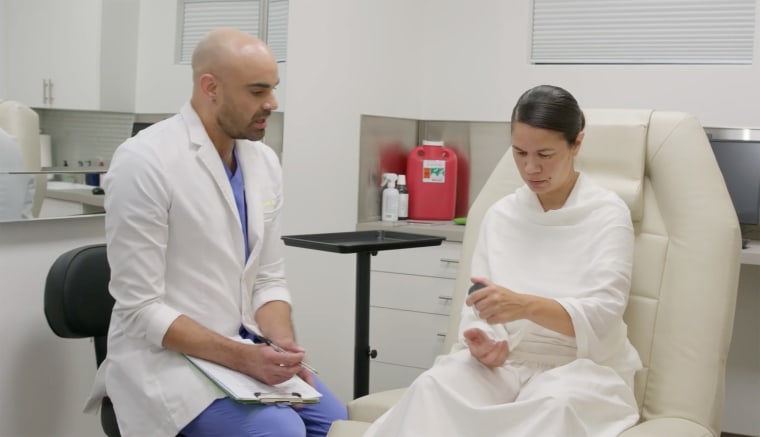About 90 minutes from Dallas, in a north Texas farming community home to more cows than people, sits an ashram where two Jain monks and documentary filmmakers, Sadhvi Siddhali Shree, 41, and Sadhvi Anubhuti, 42, are on a spiritual journey of a whole other kind.
A few years ago, at 38, Shree, a former Iraqi War veteran, started feeling “off.” She wasn’t sleeping and had trouble concentrating. After experiencing a moment of rage, she knew something was wrong. Anubhuti wasn’t doing well either, with symptoms that started as fatigue and lack of focus becoming much more pronounced.
The two holy women scoured social media for answers and came across a term both were unfamiliar with — perimenopause. At the advice of their nurse practitioner, they decided to get their hormone levels checked.
An at-home test revealed that Shree had low progesterone levels, an early indication of perimenopause, the transitional period before menopause. “It was a relief to know,” Shree said. “It’s a medical situation. It’s not me feeling like I’m going crazy.”

Anubhuti’s test revealed that she had practically no estrogen in her system, which left her feeling depleted and sad. “It was disappointing at first, because when you think of being menopausal, you don’t think of it as when you’re 30 or 40, right?”
The average age for menopause is 51. Most women begin experiencing perimenopausal symptoms between the ages of 35 and 45, although a recent study, published in the journal NPJ Women’s Health, found that a significant number of women under 35, some as young as 30, reported moderate to severe symptoms.
During perimenopause — which can last four to eight years — the ovaries produce decreasing amounts of the reproductive hormones estrogen and progesterone. The drop in hormones can cause a range of symptoms, including irregular periods, hot flashes and sleep problems, along with mood changes, vaginal and bladder issues, decreased libido and bone loss. Cholesterol levels may begin to increase, which may eventually lead to heart disease.
Shree was having trouble sleeping due to the lack of progesterone in her system, so she started hormone replacement therapy (HRT), which has been shown to help with sleep problems associated with perimenopause.

“As monks we tend to do things more naturally; we try to avoid medicine unless it’s absolutely necessary,” Shree said, adding that “desperate times called for desperate measures.”
Anubhuti treated her symptoms, including fatigue, lack of focus and hair loss, with the help of a naturopathic doctor who advised her on supplements and encouraged her to eat more plant-based proteins and omega-3s.
Early symptoms of perimenopause may take some women by surprise and can be incredibly disruptive. Doctors may not always offer relief. A recent Mayo Clinic study found that nearly 20% of medical residents surveyed reported not getting any menopause lectures or training. Only 7% of those doctors felt they were adequately prepared to treat women going through this transition.
But as more millennial women reach this transitional age, they’re turning to social media to share advice and remind others they aren’t alone.
Shree and Anubhuti, who typically work with people coping with anxiety and PTSD, are now taking an active role in raising awareness of perimenopause. The Jain monks, as filmmakers, have been documenting their entire medical journey, from their first appointments with the nurse practitioner to interviews with top menopause experts such as Dr. Mary Claire Haver, Dr. Vonda Wright and Dr. Louise Newson, for an online docuseries called “Balance.” They’ve been sharing portions of it at home screenings dubbed “peri-parties” around the world.
“Part of our mission is to help alleviate and reduce pain and suffering in this world,” Anubhuti said. “We have now found out that there is a silent suffering that a lot of women are going through, not knowing the options that we have for treatment, not knowing where to go for help.”
In early February, Stephanie Collins, a women’s health advocate in Dallas, invited 50 womenages 33 to 60 to a screening. The goal, according to Collins, is to help change the narrative around how women in midlife are talked about and treated by doctors.
“Many of these women have been dismissed by the medical community, that this [menopause] is just a fact of aging. To suck it up,” Collins said.
At the Dallas gathering, Dr. Lyndsey Harper, an OB-GYN, said, “The state of women’s health, for the history of it, has been terrible. We have been understudied, under-addressed.”
Back at the spiritual retreat in Windom, Texas, Shree and Anubhuti reflect on the journey.
“Perimenopause is inevitable,” Anubhuti said. “Menopause is inevitable. But what doesn’t need to be inevitable is the pain and suffering that we experience as women as we go through this shift.”
Shree agreed, adding, “What’s beautiful is that we become even closer.”
